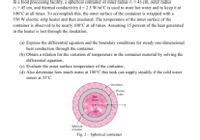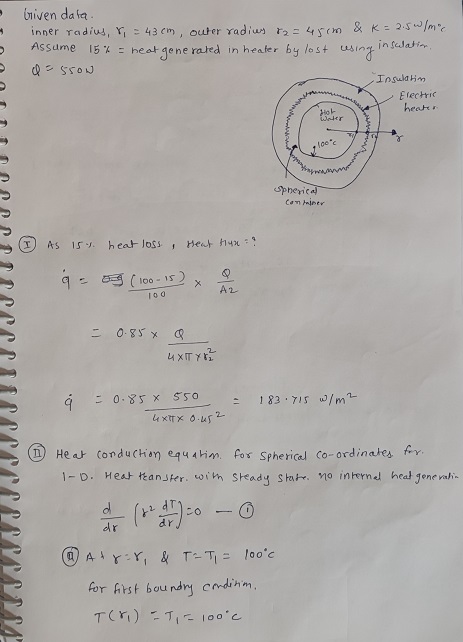
Elements Of Electromagnetics
7th Edition
ISBN: 9780190698614
Author: Sadiku, Matthew N. O.
Publisher: Oxford University Press
expand_more
expand_more
format_list_bulleted
Question

Transcribed Image Text:In a food processing facility, a spherical container of inner radius ri = 43 cm, outer radius
r2 = 45 cm, and thermal conductivity k= 2.5 W/m°C is used to store hot water and to keep it at
100°C at all times. To accomplish this, the outer surface of the container is wrapped with a
550 W electric strip heater and then insulated. The temperature of the inner surface of the
container is observed to be nearly 100°C at all times. Assuming 15 percent of the heat generated
in the heater is lost through the insulation.
(a) Express the differential equation and the boundary conditions for steady one-dimensional
heat conduction through the container,
(b) Obtain a relation for the variation of temperature in the container material by solving the
differential equation,
(c) Evaluate the outer surface temperature of the container,
(d) Also determine how much water at 100°C this tank can supply steadily if the cold water
enters at 35°C.
-Insulation
- Electric
heater
Ho
water
Spherical
container
Fig. 2 – Spherical container
Expert Solution
arrow_forward
Step 1

Trending nowThis is a popular solution!
Step by stepSolved in 3 steps with 3 images

Knowledge Booster
Learn more about
Need a deep-dive on the concept behind this application? Look no further. Learn more about this topic, mechanical-engineering and related others by exploring similar questions and additional content below.Similar questions
- Consider a stainless steel spoon ( k = 8.7 Btu/hrft°F) partially immersed in boiling water at 200 deg * F in a kitchen at 75°F. The handle of the spoon has a cross section of 0.08in * 0.5in and extends 7 inches into the air from the free surface of the water. If the heat transfer coefficient at the exposed surfaces of the spoon handle is 3 Btu/hrft²°F, determine the temperature of the tip of the spoon handle. Assume that the heat loss from the tip of the spoon is negligible.arrow_forwardConsider the base plate of a 750-W household iron with a thickness of L=0.6 cm, base area of A=170 cm2, and thermal conductivity of k=22 W/m.oC. The inner surface of the base plate is subjected to uniform heat flux generated by the resistance heaters inside. When steady operating conditions are reached, the outer surface temperature of the plate is measured to be 85 oC. Disregarding any heat loss through the upper part of the iron, (a) express the differential equation and the boundary conditions for steady one-dimensional heat conduction through the plate, (b) obtain a relation for the variation of temperature in the base plate by solving the differential equation, and (c) evaluate the inner surface temperature.arrow_forwardA glass window with an area of 0.625 m² is installed in the wooden outside wall of a room. The wall dimensions are 25 x 3.05 m. The wood has a k of 0.151W/m.K and is 3.05 cm thick. The glass has a k of 0.692W/m.K and is 5.0 mm thick. The temperature of the inside room is 27°C and outside air temperature is 268K. (1)What is the heat loss through wooden wall and glass window q(W) ? (2) What are the total heat loss?arrow_forward
Recommended textbooks for you
 Elements Of ElectromagneticsMechanical EngineeringISBN:9780190698614Author:Sadiku, Matthew N. O.Publisher:Oxford University Press
Elements Of ElectromagneticsMechanical EngineeringISBN:9780190698614Author:Sadiku, Matthew N. O.Publisher:Oxford University Press Mechanics of Materials (10th Edition)Mechanical EngineeringISBN:9780134319650Author:Russell C. HibbelerPublisher:PEARSON
Mechanics of Materials (10th Edition)Mechanical EngineeringISBN:9780134319650Author:Russell C. HibbelerPublisher:PEARSON Thermodynamics: An Engineering ApproachMechanical EngineeringISBN:9781259822674Author:Yunus A. Cengel Dr., Michael A. BolesPublisher:McGraw-Hill Education
Thermodynamics: An Engineering ApproachMechanical EngineeringISBN:9781259822674Author:Yunus A. Cengel Dr., Michael A. BolesPublisher:McGraw-Hill Education Control Systems EngineeringMechanical EngineeringISBN:9781118170519Author:Norman S. NisePublisher:WILEY
Control Systems EngineeringMechanical EngineeringISBN:9781118170519Author:Norman S. NisePublisher:WILEY Mechanics of Materials (MindTap Course List)Mechanical EngineeringISBN:9781337093347Author:Barry J. Goodno, James M. GerePublisher:Cengage Learning
Mechanics of Materials (MindTap Course List)Mechanical EngineeringISBN:9781337093347Author:Barry J. Goodno, James M. GerePublisher:Cengage Learning Engineering Mechanics: StaticsMechanical EngineeringISBN:9781118807330Author:James L. Meriam, L. G. Kraige, J. N. BoltonPublisher:WILEY
Engineering Mechanics: StaticsMechanical EngineeringISBN:9781118807330Author:James L. Meriam, L. G. Kraige, J. N. BoltonPublisher:WILEY

Elements Of Electromagnetics
Mechanical Engineering
ISBN:9780190698614
Author:Sadiku, Matthew N. O.
Publisher:Oxford University Press

Mechanics of Materials (10th Edition)
Mechanical Engineering
ISBN:9780134319650
Author:Russell C. Hibbeler
Publisher:PEARSON

Thermodynamics: An Engineering Approach
Mechanical Engineering
ISBN:9781259822674
Author:Yunus A. Cengel Dr., Michael A. Boles
Publisher:McGraw-Hill Education

Control Systems Engineering
Mechanical Engineering
ISBN:9781118170519
Author:Norman S. Nise
Publisher:WILEY

Mechanics of Materials (MindTap Course List)
Mechanical Engineering
ISBN:9781337093347
Author:Barry J. Goodno, James M. Gere
Publisher:Cengage Learning

Engineering Mechanics: Statics
Mechanical Engineering
ISBN:9781118807330
Author:James L. Meriam, L. G. Kraige, J. N. Bolton
Publisher:WILEY